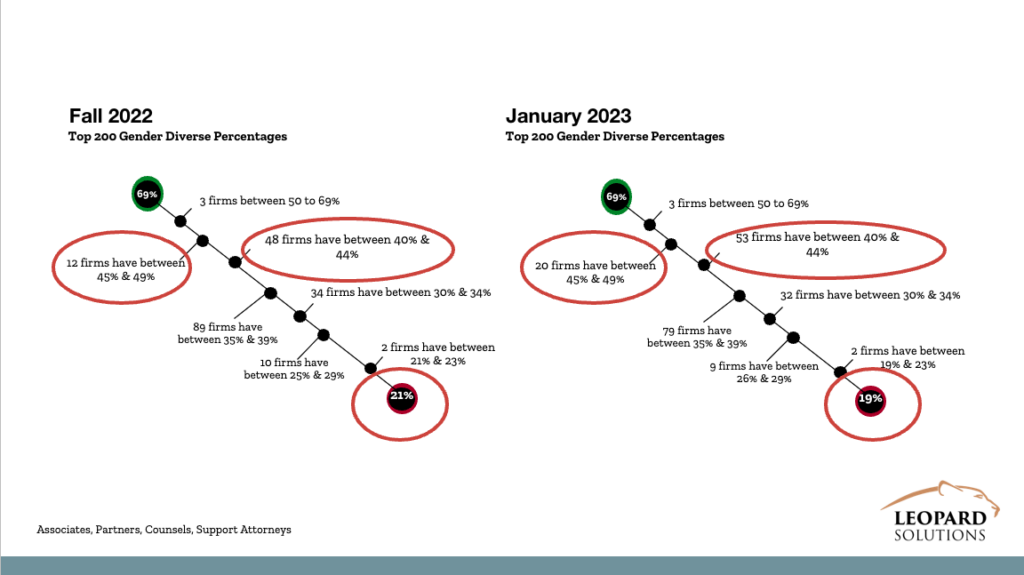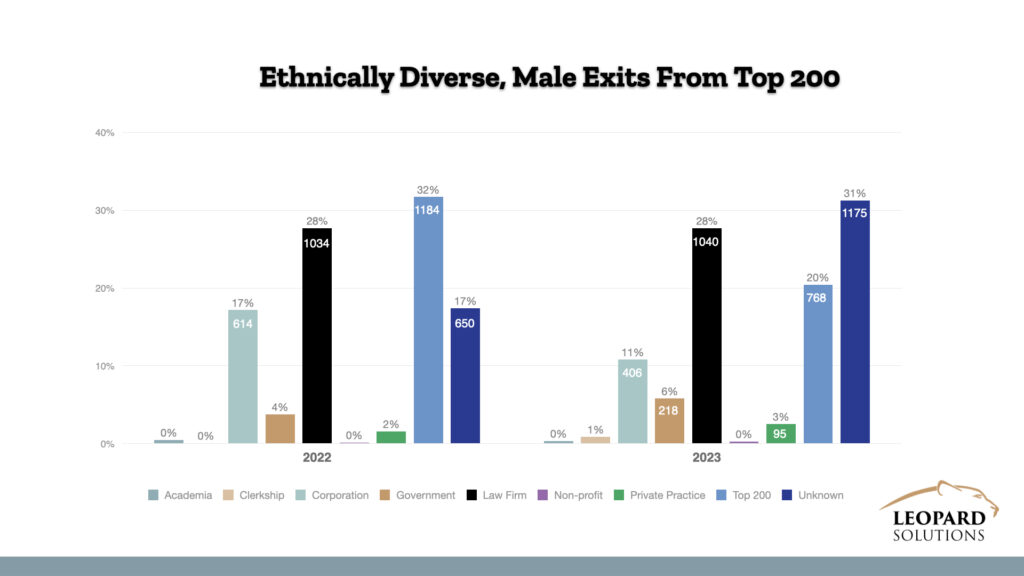The New York Times recently ran a lengthy expose entitled “America is Under Attack: Inside the Anti-D.E.I. Crusade,” which detailed the conservative movement to reverse the perceived progressive agenda pervasive at public higher learning institutions. An uncovered tranche of documents revealed the scope of the cynicism at play, the dark and unhidden money backing the movement, and the playbook of intimidatory maneuvering used to get left-leaning academia to bend. The revelations, unconscionable callousness, and tactics exhibited in the insider emails are shocking but unsurprising to anyone who has covered the legal industry over the past two years. If one were to connect the dots, the legal sector was, by design, the first battlefield for right-wing PACs and political virtue signalers to attempt to codify the culture wars by using a Supreme Court ruling against Affirmative Action to wage a fear campaign. What chance would corporations and universities have if they could get powerful Top 100 law firms to roll back DEI initiatives and decades of forward progress by the mere threat of litigation? The ripple effect was swift and profound, but what was also gleaned was that some actors were the same.
Times reporting revealed the Wisconsin-based Searle Freedom Trust was among the groups that loomed large in the effort to disentangle red states from collegiate-level wokeness by bankrolling a campaign to defund curricula that embraced social justice and critical race theory. Those very same mega-donors were principal contributors to the crusade of conservative activist Edward Blum. Infamous in law firm circles for his alleged championing of merit-based ascension, he fought to deal a fatal blow to diversity-minded hiring practices and promoting believed to disadvantage the majority unfairly. A Slate piece published in 2022 pointed out the absurdity of the optics that he was a David going against the law firm Goliaths. “The false narrative of the solo actor is perniciously common in the conservative playbook, spread by media across the political spectrum. Blum’s little-ol’-me facade was set a decade ago when he went to the Supreme Court with his first and failed anti-affirmative action case, 2012’s Fisher v. University of Texas. The Texas Tribune called him “a one-man show.” This was intentional, intended to muddle any link to the shadow operators who use vast means to advocate for a “pull yourself up by the bootstraps” society for which biases play no role in exclusion.
Law Firms Navigate Controversial Lawsuit Fallout
Fast-forward to December of 2023, Blum told Bloomberg that he was effectively ceasing his pressure campaign against law firms, citing, “There’s nothing left for us to do in that space.” This followed a two-year quest that saw his shell group, unironically titled American Alliance for Equal Rights, file suit against legal behemoths Perkins Coie, Morrison Foerster, and Winston & Strawn for white, hetero, male discrimination. The former firm defiantly told the WSJ through a spokesman” “As a firm, we have been a leader in efforts to promote diversity, equity, and inclusion in the legal profession. Our commitment to those values remains steadfast. We will defend this lawsuit vigorously.” What played out on the ground didn’t match the rhetoric. Winston & Strawn altered diversity scholarship language to circumnavigate the suit filed in the Southern District of Texas. Blum and his supporters got what they wanted: firms reactively removed all mentions of race or gender in eligibility criteria. Several other top-tier firms followed suit proactively for fear of being targeted. Going after elite firms proved to be an effective strategy. Once they caved, an atmosphere of fear permeated the landscape, getting smaller firm dominos to fall without even having so much as a day in court. It is widely expected by organizations that track recruitment data that new law firm applicant language will directly cause diversity to recede. The lack of a fight mustered could lead one to infer equity and parity at law firms for underrepresented groups was always negotiable by controlling parties. Experts called the outcome predictable, rather than face a series of costly legal losses, for the agitating AAER to retract its complaint and claim victory once the “red flag” text was amended. Some legal diversity officers want to continue the good fight. Still, for lawyer-fortified entities to wilt under a relative non-challenge, it can only call into question the appetite for widescale change. The hard reality was simple: the Supreme Court ruling was only applicable to federally funded programs and not those belonging to private law firms. While exercising maximum caution is existential to law firms, and how they support their clients, these attacks were surely defensible. The entire exercise represented a convenient means to pull back for firms never eager to die on the diversity hill in the first place. Besides the narrowly focused judicial ruling, they needed only to highlight their lackluster efforts to achieve parity in the upper echelons of their firms to show the charges were bogus. A record that counts so few members of underrepresented groups speak volumes.
Latest Leopard Data Analysis Predicting Trends on Diversity and the Urgency for Inclusive Practices
Leopard Solutions’ 2024 State of the Industry report looked at the legacy of the GOP-hardliner fearmongering. Founder and CEO Laura Leopard said, “The assault on private-sector DEI programs reaches beyond the legal industry. America First Legal, the conservative nonprofit backed by former Trump adviser Stephen Miller, has filed complaints against NASCAR, Major League Baseball, Progressive Insurance, Activision Blizzard, and Nordstrom, targeting practices ranging from establishing workplace affinity groups for employees of color to giving grants to Black-owned businesses. Law firms are now creating new practices to help firms navigate the new landscape and maintain a robust diversity program. It might produce a litigation-proof model to help diversity grow more easily in the corporate and legal sectors; only time will tell.” The hiring gap for Ethnically Diverse laterals and entry levels increased this year by 5% for laterals and 3% for entry levels. If firms do not push reset and reinstate more inclusive verbiage for fellowships, recruitment retreats, and the like, the diverse disparity will continue trending irredeemably. This self-inflicted result will have societal and bottom-line implications for the historically homogeneous profession.

We have been looking at them over the last few months after the lawsuits began. There were big swings on the ethnic diversity chart. The lowest number went down to 4%, and the highest number went up to 39% from 38%. There was some shuffling, but the number of firms with over 30% ethnically diverse employees gained two firms! Some firms lost ground, however. Please note – no one in the Top 50 firms has less than a 14% diversity score.

However, ethnically diverse males experienced a drop from 45% to 32% back into a Top 200 firm in 2022. This past year, they returned to an even lower percentage, 12% lower at just 20%.
While the clear and present offensive against law firm DEI programs appears to have taken a step back following quantifiable successes, the concern remains that irreparable harm was already inflicted. From analyzing gender demographic levels at law schools, we know they directly correlate to headcount within the industry. Women overtook men in law schools, and 2023 saw that translate to women lawyers constituting a first-time 51% majority among the associate ranks. If their law school presence had declined, the opposite might be true. The broader expectation in the industry is now that the ethnically diverse student population will drop following the public onslaught against programs that foster inclusivity. It’s hard to fathom that a dwindling student body would not have real-world implications for underrepresented groups already decreasing in law firm representation.

